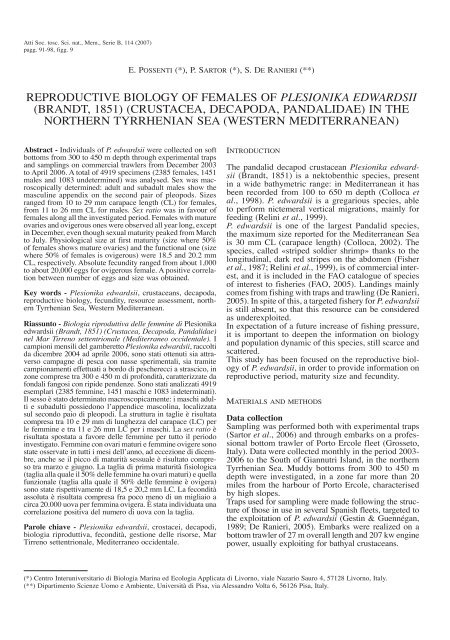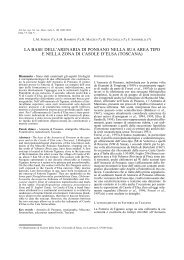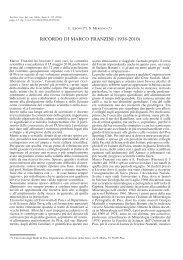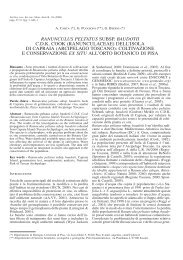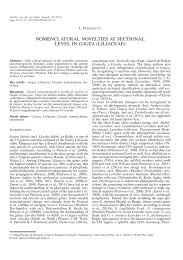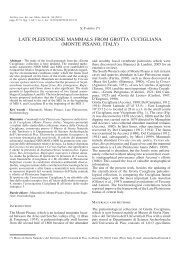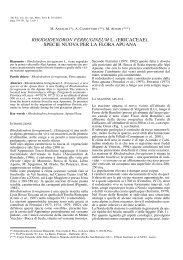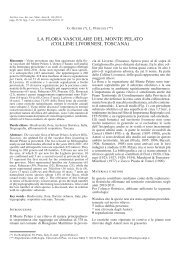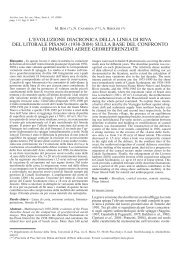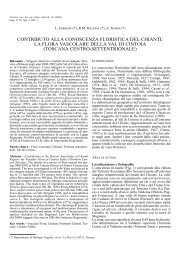reproductive biology of females of plesionika edwardsii
reproductive biology of females of plesionika edwardsii
reproductive biology of females of plesionika edwardsii
Create successful ePaper yourself
Turn your PDF publications into a flip-book with our unique Google optimized e-Paper software.
Atti Soc. tosc. Sci. nat., Mem., Serie B, 114 (2007)<br />
pagg. 91-98, figg. 9<br />
e. PoSSenti (*), P. Sartor (*), S. de ranieri (**)<br />
REPRODUCTIVE BIOLOGY OF FEMALES OF PLESIONIKA EDWARDSII<br />
(BRANDT, 1851) (CRUSTACEA, DECAPODA, PANDALIDAE) IN THE<br />
NORTHERN TYRRHENIAN SEA (WESTERN MEDITERRANEAN)<br />
Abstract - Individuals <strong>of</strong> P. <strong>edwardsii</strong> were collected on s<strong>of</strong>t<br />
bottoms from 300 to 450 m depth through experimental traps<br />
and samplings on commercial trawlers from December 2003<br />
to April 2006. A total <strong>of</strong> 4919 specimens (2385 <strong>females</strong>, 1451<br />
males and 1083 undetermined) was analysed. Sex was macroscopically<br />
determined: adult and subadult males show the<br />
masculine appendix on the second pair <strong>of</strong> pleopods. Sizes<br />
ranged from 10 to 29 mm carapace length (CL) for <strong>females</strong>,<br />
from 11 to 26 mm CL for males. Sex ratio was in favour <strong>of</strong><br />
<strong>females</strong> along all the investigated period. Females with mature<br />
ovaries and ovigerous ones were observed all year long, except<br />
in December, even though sexual maturity peaked from March<br />
to July. Physiological size at first maturity (size where 50%<br />
<strong>of</strong> <strong>females</strong> shows mature ovaries) and the functional one (size<br />
where 50% <strong>of</strong> <strong>females</strong> is ovigerous) were 18.5 and 20.2 mm<br />
CL, respectively. Absolute fecundity ranged from about 1,000<br />
to about 20,000 eggs for ovigerous female. A positive correlation<br />
between number <strong>of</strong> eggs and size was obtained.<br />
Key words - Plesionika <strong>edwardsii</strong>, crustaceans, decapoda,<br />
<strong>reproductive</strong> <strong>biology</strong>, fecundity, resource assessment, northern<br />
Tyrrhenian Sea, Western Mediterranean.<br />
Riassunto - Biologia riproduttiva delle femmine di Plesionika<br />
<strong>edwardsii</strong> (Brandt, 1851) (Crustacea, Decapoda, Pandalidae)<br />
nel Mar Tirreno settentrionale (Mediterraneo occidentale). I<br />
campioni mensili del gamberetto Plesionika <strong>edwardsii</strong>, raccolti<br />
da dicembre 2004 ad aprile 2006, sono stati ottenuti sia attraverso<br />
campagne di pesca con nasse sperimentali, sia tramite<br />
campionamenti effettuati a bordo di pescherecci a strascico, in<br />
zone comprese tra 300 e 450 m di pr<strong>of</strong>ondità, caratterizzate da<br />
fondali fangosi con ripide pendenze. Sono stati analizzati 4919<br />
esemplari (2385 femmine, 1451 maschi e 1083 indeterminati).<br />
Il sesso è stato determinato macroscopicamente: i maschi adulti<br />
e subadulti possiedono l’appendice mascolina, localizzata<br />
sul secondo paio di pleopodi. La struttura in taglie è risultata<br />
compresa tra 10 e 29 mm di lunghezza del carapace (LC) per<br />
le femmine e tra 11 e 26 mm LC per i maschi. La sex ratio è<br />
risultata spostata a favore delle femmine per tutto il periodo<br />
investigato. Femmine con ovari maturi e femmine ovigere sono<br />
state osservate in tutti i mesi dell’anno, ad eccezione di dicembre,<br />
anche se il picco di maturità sessuale è risultato compreso<br />
tra marzo e giugno. La taglia di prima maturità fisiologica<br />
(taglia alla quale il 50% delle femmine ha ovari maturi) e quella<br />
funzionale (taglia alla quale il 50% delle femmine è ovigera)<br />
sono state rispettivamente di 18,5 e 20,2 mm LC. La fecondità<br />
assoluta è risultata compresa fra poco meno di un migliaio a<br />
circa 20.000 uova per femmina ovigera. È stata individuata una<br />
correlazione positiva del numero di uova con la taglia.<br />
Parole chiave - Plesionika <strong>edwardsii</strong>, crostacei, decapodi,<br />
biologia riproduttiva, fecondità, gestione delle risorse, Mar<br />
Tirreno settentrionale, Mediterraneo occidentale.<br />
introduction<br />
The pandalid decapod crustacean Plesionika <strong>edwardsii</strong><br />
(Brandt, 1851) is a nektobenthic species, present<br />
in a wide bathymetric range: in Mediterranean it has<br />
been recorded from 100 to 650 m depth (Colloca et<br />
al., 1998). P. <strong>edwardsii</strong> is a gregarious species, able<br />
to perform nictemeral vertical migrations, mainly for<br />
feeding (Relini et al., 1999).<br />
P. <strong>edwardsii</strong> is one <strong>of</strong> the largest Pandalid species,<br />
the maximum size reported for the Mediterranean Sea<br />
is 30 mm CL (carapace length) (Colloca, 2002). The<br />
species, called «striped soldier shrimp» thanks to the<br />
longitudinal, dark red stripes on the abdomen (Fisher<br />
et al., 1987; Relini et al., 1999), is <strong>of</strong> commercial interest,<br />
and it is included in the FAO catalogue <strong>of</strong> species<br />
<strong>of</strong> interest to fisheries (FAO, 2005). Landings mainly<br />
comes from fishing with traps and trawling (De Ranieri,<br />
2005). In spite <strong>of</strong> this, a targeted fishery for P. <strong>edwardsii</strong><br />
is still absent, so that this resource can be considered<br />
as underexploited.<br />
In expectation <strong>of</strong> a future increase <strong>of</strong> fishing pressure,<br />
it is important to deepen the information on <strong>biology</strong><br />
and population dynamic <strong>of</strong> this species, still scarce and<br />
scattered.<br />
This study has been focused on the <strong>reproductive</strong> <strong>biology</strong><br />
<strong>of</strong> P. <strong>edwardsii</strong>, in order to provide information on<br />
<strong>reproductive</strong> period, maturity size and fecundity.<br />
materiaLS and methodS<br />
Data collection<br />
Sampling was performed both with experimental traps<br />
(Sartor et al., 2006) and through embarks on a pr<strong>of</strong>essional<br />
bottom trawler <strong>of</strong> Porto Ercole fleet (Grosseto,<br />
Italy). Data were collected monthly in the period 2003-<br />
2006 to the South <strong>of</strong> Giannutri Island, in the northern<br />
Tyrrhenian Sea. Muddy bottoms from 300 to 450 m<br />
depth were investigated, in a zone far more than 20<br />
miles from the harbour <strong>of</strong> Porto Ercole, characterised<br />
by high slopes.<br />
Traps used for sampling were made following the structure<br />
<strong>of</strong> those in use in several Spanish fleets, targeted to<br />
the exploitation <strong>of</strong> P. <strong>edwardsii</strong> (Gestin & Guennégan,<br />
1989; De Ranieri, 2005). Embarks were realized on a<br />
bottom trawler <strong>of</strong> 27 m overall length and 207 kw engine<br />
power, usually exploiting for bathyal crustaceans.<br />
(*) Centro Interuniversitario di Biologia Marina ed Ecologia Applicata di Livorno, viale Nazario Sauro 4, 57128 Livorno, Italy.<br />
(**) Dipartimento Scienze Uomo e Ambiente, Università di Pisa, via Alessandro Volta 6, 56126 Pisa, Italy.
92 E. POSSENTI, P. SARTOR, S. DE RANIERI<br />
Laboratory analysis<br />
Size was registered as carapace length (CL, to 0.1<br />
mm) on each specimen caught, with a precision calliper,<br />
from the posterior tip <strong>of</strong> the eye socket to the end<br />
<strong>of</strong> the carapace. Sex was assigned on the basis <strong>of</strong> the<br />
presence <strong>of</strong> the male secondary sexual characters. Adult<br />
and subadult males show two sexual appendages, one<br />
<strong>of</strong> them, the «masculine appendix», is located near the<br />
endopod <strong>of</strong> the second pair <strong>of</strong> pleopods (Fig. 1); this<br />
appendix is particularly small in juveniles and difficult<br />
to recognize (King & M<strong>of</strong>fitt, 1984).<br />
Maturity <strong>of</strong> <strong>females</strong> was determined through the macroscopic<br />
analysis <strong>of</strong> the ovaries, their size and coloration.<br />
Three maturity stages were assigned, according to<br />
Ceccaldi (1966) and Company & Sardà (1997): stage I<br />
(immature), ovary small, pale, yellow-pinkish; stage II<br />
(maturing), ovary developed, light blue-violet; stage III<br />
(mature), ovary fully developed, dark blue.<br />
Females were also classified as ovigerous and nonovigerous;<br />
ovigerous <strong>females</strong> were further classified in<br />
stage 1 (light blue eggs, without embryo pigmentation)<br />
and stage 2 (light brown-grey eggs, with embryos in<br />
different stages or fully developed larvae).<br />
Total fecundity was estimated on monthly samples <strong>of</strong><br />
24 <strong>females</strong> with eggs in the two development stages;<br />
samples were chosen according to four female size<br />
classes (15-18 mm CL, 19-22 mm CL, 23-26 mm CL,<br />
27-30 mm CL). Totally, eggs <strong>of</strong> 267 <strong>females</strong> (137 stage<br />
1, 130 stage 2) were counted.<br />
Counts were performed on sampling basis. For each<br />
female, the ovary content was placed in a Dollfuss<br />
cell <strong>of</strong> 200 square boxes <strong>of</strong> 0.5 mm side each; eggs<br />
<strong>of</strong> 25 boxes (1/8 <strong>of</strong> the total), randomly chosen, were<br />
counted. A preliminary analysis (Possenti, unpublished<br />
data) showed that this sample size was large enough to<br />
keep down in ± 10% the estimate error.<br />
Data analysis<br />
Sex ratio was calculated as percentage <strong>of</strong> <strong>females</strong> on the<br />
total sampled population. Differences from the expected<br />
1:1 sex ratio were investigated by Chi square test,<br />
applied to the samples <strong>of</strong> each month, when the catches<br />
were greater than 50 specimens.<br />
The <strong>reproductive</strong> period was investigated monthly,<br />
tacking into account the percentage <strong>of</strong> <strong>females</strong> in the<br />
different maturity stages <strong>of</strong> gonads and eggs.<br />
Maturity size was estimated by calculating the size at<br />
which 50% <strong>of</strong> <strong>females</strong> were mature (physiological maturity)<br />
as well as the size at which 50% <strong>of</strong> <strong>females</strong> carried<br />
eggs on pleopods (functional maturity). In both cases a<br />
logistic curve was adapted to the experimental data.<br />
Total fecundity was calculated raising the egg counts<br />
coming from the Dollfuss sampled boxes to the total<br />
Dollfuss boxes. Relative fecundity was estimated<br />
through the linear regression between number <strong>of</strong> eggs<br />
and carapace length.<br />
reSuLtS<br />
Sex-ratio<br />
4919 specimens were collected, ranging from 10 to 29<br />
mm CL; the smallest ones were caught in May (modal<br />
size at 14 mm CL), June and July, the largest in winter<br />
(modal size 20-22 mm CL).<br />
Sex was assigned on all the specimens from 15 mm CL;<br />
under this size, sex identification was difficult, because<br />
the male secondary sexual characters were not present<br />
or little developed.<br />
1451 males and 2385 <strong>females</strong> were collected, showing<br />
a sex ratio <strong>of</strong> 62% (Chi square = 167, p < 0.001). At<br />
monthly level, <strong>females</strong> always significantly outnumbered<br />
males; only in three months the Chi square test<br />
gave not significant differences. Males ranged from<br />
15 to 26 mm CL, <strong>females</strong> from 15 to 29 mm CL; the<br />
percentage <strong>of</strong> <strong>females</strong> by size class was always more<br />
than 50% (Fig. 2).<br />
Maturity period<br />
Specimens in the three maturity stages were caught<br />
each month, even though in different percentages,<br />
except in December.<br />
Fig. 1 - P. <strong>edwardsii</strong>. Detail <strong>of</strong> the second pleopod with masculine appendix (MA) <strong>of</strong> the adult male.
REPRODUCTIVE BIOLOGY OF FEMALES OF PLESIONIKA EDWARDSII (BRANDT, 1851) IN ThE NORThERN TyRRhENIAN SEA<br />
Fig. 2 - P. <strong>edwardsii</strong>. Percentage <strong>of</strong> <strong>females</strong> by size class. ■ = No significant differences for sex ratio 1:1 (Chi square test).<br />
Maturation <strong>of</strong> gonads showed a clear seasonal trend<br />
(Fig. 3). Mature <strong>females</strong> were concentrated in spring,<br />
with a peak in April, decreased in the following months<br />
to disappear in winter. Immature specimens were<br />
present all year round, but prevailed in winter.<br />
Ovigerous <strong>females</strong><br />
The temporal evolution <strong>of</strong> the presence <strong>of</strong> ovigerous<br />
<strong>females</strong> is shown in Figure 4; the highest percentages<br />
were observed in spring and summer (92% in April<br />
and 70% in June). Ovigerous <strong>females</strong> decreased in the<br />
following months and disappeared in December. The<br />
presence <strong>of</strong> <strong>females</strong> with eggs in advanced development<br />
stage (stage 2) did not show evident seasonal<br />
differences, even though these specimens were always<br />
less abundant than the <strong>females</strong> with eggs in stage 1.<br />
Size at first sexual maturity<br />
The smallest <strong>females</strong> bearing eggs were 15 mm CL,<br />
and the smallest female with mature ovaries measured<br />
13 mm CL. All the <strong>females</strong> over 27 mm CL had mature<br />
gonads; all <strong>females</strong> over 28 mm CL were ovigerous.<br />
The logistic curve gave a good fit <strong>of</strong> the observed data<br />
on the proportion <strong>of</strong> mature <strong>females</strong> by each size (Fig.<br />
5). Physiological size at first maturity was 18.5 mm<br />
CL (Fig. 6).<br />
Functional size at first maturity, calculated by using the<br />
presence <strong>of</strong> eggs on pleopods like criterion, was 20.2<br />
mm CL; also in this case the logistic curve well fitted<br />
the observed data.<br />
Taking into account only the adult <strong>females</strong> (i.e. the<br />
<strong>females</strong> larger than 18.0 mm CL, the size at first maturity),<br />
the temporal evolution <strong>of</strong> maturity (Fig. 7) shows<br />
the same pattern <strong>of</strong> that <strong>of</strong> the whole sample (Fig. 3).<br />
Fecundity<br />
The minimum and maximum number <strong>of</strong> eggs were 920<br />
(recorded in a female <strong>of</strong> 21 mm CL) and 19,792 (in a<br />
specimen <strong>of</strong> 25 mm CL), respectively.<br />
93<br />
The estimations <strong>of</strong> total fecundity coming from the<br />
specimens caught by trawling gave, for each size class,<br />
values considerably lower than those from the individuals<br />
caught by traps (Fig. 8). Relative fecundity was<br />
significantly positively correlated to the animal size<br />
(CL) by a linear relationship (Fig. 9). The slope <strong>of</strong> the<br />
regression line decreased <strong>of</strong> about 15% moving from<br />
the relationship for the <strong>females</strong> with eggs in stage 1<br />
(Fig. 9A) to that for the <strong>females</strong> in stage 2 (Fig. 9B).<br />
This difference could be related to the loss <strong>of</strong> eggs during<br />
the brooding period.<br />
diScuSSion<br />
The size range <strong>of</strong> the collected individuals (10-29 mm<br />
CL) was similar to that reported in other studies carried<br />
out in the Mediterranean Sea (Guennégan et al.,<br />
1992; Company & Sardà, 1997; Garcia-Rodriguez et<br />
al., 2000; Colloca, 2002).<br />
On the other hand, Santana et al. (1997), in the southeastern<br />
Atlantic Ocean (Canary Islands), observed<br />
greater maximum sizes, both for males (34 mm CL)<br />
and <strong>females</strong> (40 mm CL).<br />
Sex ratio was shifted in favour <strong>of</strong> <strong>females</strong>, while Guennégan<br />
et al. (1992) and Garcia-Rodriguez et al. (2000)<br />
reported a proportion <strong>of</strong> sexes <strong>of</strong> around 50%. Colloca<br />
(2002) observed a sex ratio in favour <strong>of</strong> <strong>females</strong> between<br />
100 and 200 m, around 1:1 or in favour <strong>of</strong> males between<br />
200 and 250 m; at depths greater than 250 m, <strong>females</strong><br />
were predominant. Such differences were probably due<br />
to the different bathymetric ranges investigated, tacking<br />
into account the size-depth relationship showed by this<br />
species (Company & Sardà, 1997).<br />
A different sex ratio by depth was also observed in other<br />
species <strong>of</strong> the genus Plesionika, except P. acanthonotus;<br />
P. gigliolii shows higher proportion <strong>of</strong> <strong>females</strong> between<br />
350 and 450 m, whereas <strong>females</strong> <strong>of</strong> P. martia prevail at<br />
depths greater than 450 m (Company & Sardà, 1997).
94 E. POSSENTI, P. SARTOR, S. DE RANIERI<br />
Fig. 3 - P. <strong>edwardsii</strong>. Percentage <strong>of</strong> <strong>females</strong> in the three maturity stages, by month.<br />
Fig. 4 - P. <strong>edwardsii</strong>. Monthly proportion <strong>of</strong> ovigerous <strong>females</strong> (eggs in stage 1 and in stage 2) and non-ovigerous <strong>females</strong>.<br />
Fig. 5 - P. <strong>edwardsii</strong>. Physiological size at first maturity.
REPRODUCTIVE BIOLOGY OF FEMALES OF PLESIONIKA EDWARDSII (BRANDT, 1851) IN ThE NORThERN TyRRhENIAN SEA<br />
Fig. 6 - P. <strong>edwardsii</strong>. Functional size at first maturity.<br />
Fig. 7 - P. <strong>edwardsii</strong>. Percentage <strong>of</strong> adult <strong>females</strong> (CL ≥ 18.5 mm) in the three maturity stages, by month.<br />
Fig. 8 - P. <strong>edwardsii</strong>. Average fecundity by size class, according to specimens sampled with embarks on a pr<strong>of</strong>essional trawler or with<br />
experimental traps.<br />
95
96 E. POSSENTI, P. SARTOR, S. DE RANIERI<br />
Fig. 9 - P. <strong>edwardsii</strong>. Relationship between egg number and carapace length, for <strong>females</strong> with eggs in stage 1 (A) and in stage 2 (B).<br />
The seasonal pattern <strong>of</strong> female maturity observed in this<br />
study substantially agrees with that reported by Colloca<br />
(2002) for the central Thyrrenian Sea, Guennégan et<br />
al. (1992) for the north-central Thyrrenian Sea and by<br />
Company & Sardà (1997) for the Catalan Sea: mature<br />
<strong>females</strong> are present all year round, but they show a peak<br />
in spring. Ovigerous <strong>females</strong> have two periods <strong>of</strong> maximum<br />
presence, one in spring and another in summer.<br />
Little differences were reported by Garcia-Rodriguez<br />
et al. (2000) in the Levante Sea (Murcia), where the<br />
percentage <strong>of</strong> mature <strong>females</strong> was higher in autumn.<br />
A wider spawning season characterises P. <strong>edwardsii</strong> in<br />
tropical and sub tropical oceanic areas (Poupin et al.,<br />
1990; Santana et al., 1997).<br />
A wide <strong>reproductive</strong> period seems to be a typical feature<br />
<strong>of</strong> species distributed on deep bottoms, where<br />
environmental conditions are costant (Tyler, 1988).<br />
Temperature is the main abiotic factor wich can determine<br />
egg incubation in crustaceans (Wear, 1974; Sastry,<br />
1983).<br />
The estimated physiological maturity size (18.5 mm<br />
CL) is close to those reported by Guennégan et al.<br />
(1992) and Colloca (2002) (18 and 17.9 mm CL,<br />
respectively), while the functional one (20.2 mm CL)<br />
is slightly different from those reported by the same<br />
authors (18.4 and 21.8 mm CL, respectively).<br />
As concerns fecundity, Guennégan et al. (1992) and<br />
Company & Sardà (1997) reported values <strong>of</strong> total<br />
fecundity lower than those obtained in the present<br />
work; they observed a maximum <strong>of</strong> 13,000 eggs per<br />
ovigerous female, whereas in this study the maximum<br />
value <strong>of</strong> fecundity was around 20,000 eggs for female.<br />
This probably depends to the sample size: in the present<br />
study eggs from 267 ovaries were counted, while the<br />
other authors worked on considerably smaller samples.<br />
Results showed that sampling gear affects the estimates<br />
<strong>of</strong> fecundity: at the same size <strong>females</strong> collected with<br />
traps showed a number <strong>of</strong> eggs significantly higher than<br />
those <strong>of</strong> the <strong>females</strong> caught by trawling. As a matter <strong>of</strong><br />
fact, trawl fishing is in general a high «stressing» sampling<br />
gear: specimens are subjected to several injuries<br />
during trawling, hauling, sorting on board, etc., which<br />
also produce the loss <strong>of</strong> eggs from the pleopods during<br />
all the fishing operations.<br />
In other species <strong>of</strong> crustaceans carrying eggs on pleopods<br />
lower fecundity estimates were obtained. Gramitto<br />
& Froglia (1980), Morizur et al. (1981), Mori et al.
REPRODUCTIVE BIOLOGY OF FEMALES OF PLESIONIKA EDWARDSII (BRANDT, 1851) IN ThE NORThERN TyRRhENIAN SEA<br />
(2001) reported a maximum number <strong>of</strong> eggs <strong>of</strong> about<br />
10,000 for Nephrops norvegicus; Company & Sardà<br />
(1997) and Maiorano et al. (2002) estimated about 3,000<br />
eggs for P. gigliolii and P. acanthonotus, 6-7,000 for P.<br />
heterocarpus, 11,000 for P. martia. These differences<br />
could be due both to the size and the habitat <strong>of</strong> the different<br />
species. P. <strong>edwardsii</strong> is, among pandalids, one <strong>of</strong><br />
the biggest size species and less linked to the bottom.<br />
Many decapod species show strategies to minimize the<br />
egg loss during their development: in the <strong>females</strong> <strong>of</strong><br />
P. <strong>edwardsii</strong>, during moult that come before copula,<br />
ovigerous setae and other modifications to keep eggs<br />
appear on pleopods; these expedients disappear with<br />
the next moult; eggs are fixed on pleopods by a liquid<br />
constituting a very resistant weave, which totally<br />
breaks up when larvae are released (Ceccaldi, 1966).<br />
Fecundity <strong>of</strong> P. <strong>edwardsii</strong> was proportional to animal<br />
size; the same was reported by other authors in other<br />
decapod species (Gramitto & Froglia, 1980; Morizur et<br />
al., 1981; Abellò & Sardà, 1982; Mori et al., 2004). A<br />
decrease <strong>of</strong> about 15% <strong>of</strong> the number <strong>of</strong> eggs during<br />
their development on the pleopods has been supposed;<br />
Guennégan et al. (1992) estimated a loss <strong>of</strong> about 35%.<br />
The main causes <strong>of</strong> egg loss are aborted development,<br />
mechanical injuries due the fishing operations, maternal<br />
cannibalism, predation and parasitism (Kuris, 1991).<br />
P. <strong>edwardsii</strong> is a species <strong>of</strong> a certain commercial interest<br />
(15-25 euro/kg at the auctions); in spite <strong>of</strong> this, a targeted<br />
fishery is still absent and the species is only a by-catch<br />
<strong>of</strong> many trawl fisheries (De Ranieri, 2005). Only in<br />
some restricted areas P. <strong>edwardsii</strong> is object <strong>of</strong> a specifically<br />
devoted fishery, performed with nectobenthic traps<br />
(Gonzalez et al., 1992; Guennégan et al., 1992).<br />
In order to perform a more targeted exploitation <strong>of</strong> this<br />
species also in Italian seas, the striped soldier shrimp<br />
has been object <strong>of</strong> various research projects based on<br />
the experimentation <strong>of</strong> new fishing gears (Colloca,<br />
1999; De Ranieri, 2005; Sartor et al., 2006). Traps seem<br />
to be the more promising fishing gear, to achieve the<br />
best compromise between commercial yields and sustainable<br />
exploitation <strong>of</strong> the resource.<br />
In this context, reliable and accurate estimations <strong>of</strong> the<br />
main biological parameters are the basic information to<br />
implement a future management <strong>of</strong> the fishery targeted<br />
to this species.<br />
acknowLedgementS<br />
We wish to thank Maurizio, Graziano, Ugo and Vincenzo <strong>of</strong><br />
M/P «Angela-Madre» <strong>of</strong> Porto Ercole (GR), for their cooperation<br />
and avalaibility during the work at sea. We also thank<br />
Dr. Mario Mori <strong>of</strong> the University <strong>of</strong> Genova for its suggestions<br />
and comments.<br />
referenceS<br />
Abellò P., Sardà F., 1982. The fecundity <strong>of</strong> the Norway lobster (Nephrops<br />
norvegicus) <strong>of</strong>f the Catalan and Portuguese coasts. Crustaceana<br />
43: 13-20.<br />
Ceccaldi H.J., 1966. Evolution des oeufs et cycle de reproduction<br />
chez Plesionika <strong>edwardsii</strong> (Brandt). Rec. Trav. St. Mar. Endoume.<br />
Bull. 44, fasc. 60.<br />
97<br />
Colloca F., 1999. Campagne sperimentali di pesca con le nasse per<br />
la cattura dei gamberi del genere Plesionika nell’area del Cilento<br />
- Golfo di Policastro. Ministero Politiche Agricole, Final Report:<br />
pp. 80 + Annexes.<br />
Colloca F., 2002. Life cycle <strong>of</strong> deep-water pandalid shrimps Plesionika<br />
<strong>edwardsii</strong> (Decapoda, Caridea) in the central Mediterranean<br />
Sea. J. Crust. Biol. 22 (4): 775-783.<br />
Colloca F., Cerasi S., Di Bitetto M., Ardizzone G.D., 1998. Campagne<br />
sperimentali di pesca con le nasse per la cattura di gamberi<br />
del genere Plesionika nell’area del Cilento-golfo di Policastro<br />
(Tirreno meridionale). Biol. Mar. Medit. 5 (3): 656-664.<br />
Company J.B., Sardà F., 1997. Reproductive patterns and populations<br />
characteristics in five deep-water pandalid shrimps, in the western<br />
Mediterranean along a depth gradient (150-1100 m). Mar. Ecol.<br />
Prog. Ser. 148 (1-3): 49-58.<br />
De Ranieri S., 2005. Studio di fattibilità dell’utilizzo di attrezzi<br />
selettivi per la cattura di crostacei economicamente importanti<br />
nell’ambito di una riconversione dei mestieri e di una riduzione<br />
dell’impatto sugli ecosistemi, Ministero Politiche Agricole, Alimentari<br />
e Forestali, Final report, 101 pp.<br />
FAO, 2005. Review <strong>of</strong> the state <strong>of</strong> world marine fishery resources.<br />
FAO Fish. Tech. Pap., pp. 457.<br />
Fisher W., Schneider M., Bauchot M.L., 1987. Fiches FAO d’identification<br />
des espèces pour les besoins de la pêche. (Revision 1).<br />
Méditerranée et Mer Noire. Zone de pêche 37. Volume I. Végétaux<br />
ed Invertébrés. Rome, FAO, pp. 760.<br />
Garcia-Rodriguez M., Esteban A., Perez Gil J.L., 2000. Considerations<br />
on the <strong>biology</strong> <strong>of</strong> Plesionika <strong>edwardsii</strong> (Brandt, 1851) (Decapoda,<br />
Caridea, Pandalidae) from experimental trap catches in the<br />
Spanish Western Mediterranean Sea. Sci. Mar. 64 (4): 369-379.<br />
Gestin P.G., Guennégan Y., 1989. Les fiches techniques d’engins de<br />
pêche. Equinoxe 26.<br />
Gonzalez J.A., Carrillo J., Santana J.I., Martinez Banos P., Vizuete F.,<br />
1992. La pesquéria de quisquilla, Plesionika <strong>edwardsii</strong> (Brandt,<br />
1851), con tren de nasas en el Levante español. Ensayos a pequeña<br />
escala en Canarias. Inf. Técn. Sci. Mar. 170, pp. 31.<br />
Gramitto M.E., Froglia C., 1980. Osservazioni sul potenziale riproduttivo<br />
dello scampo (Nephrops norvegicus) in Adriatico. Mem.<br />
Biol. Mar. Ocean. (Suppl. X): 213-218.<br />
Guennégan y., Costantini I., Bertrand J., Campillo A., Latrouite D.,<br />
Richet M.J., Sacchi J., 1992. Prospections en vue d’une diversification<br />
de la peche autor de la Corse. Expérience de peche<br />
à la nasse de la crevette Plesionika <strong>edwardsii</strong>. Ifremer, internal<br />
report, pp. 45.<br />
King M.G., M<strong>of</strong>fitt R.B., 1984. The sexuality <strong>of</strong> tropical deepwater<br />
shrimps (Decapoda: Pandalidae). J. Crust. Biol. 4 (4): 567-571.<br />
Kuris A.M., 1991. A review <strong>of</strong> patterns and causes <strong>of</strong> crustacean<br />
brood mortality. In: Wenner A., Kuris A. (eds.), Crustacean Egg<br />
Production: 117-141. Balkema, Rotterdam.<br />
Maiorano P., D’Onghia G., Capezzuto F., Sion L., 2002. Life-history<br />
traits <strong>of</strong> Plesionika martia (Decapoda: Caridea) from the easterncentral<br />
Mediterranean Sea. Mar. Biol. 141: 527-539.<br />
Mori M., Modena M., Biagi F., 2001. Fecundity and egg volume in<br />
Norway lobster (Nephrops norvegicus) from different depths in<br />
the Northern Tyrrhenian Sea. Sci. Mar. 65 (2): 111-116.<br />
Mori M., Sbrana M., Sartor P., De Ranieri S., 2004. Aspetti bioecologici<br />
di Munida intermedia (Crustacea, Decapoda, Anomura)<br />
nell’Arcipelago toscano meridionale (Tirreno settentrionale). Atti<br />
Soc. tosc. Sci. nat., Mem., Ser. B 111: 43-53.<br />
Morizur y., Conan G., Guènolè A., Omnés M.h., 1981. Fécondité<br />
de Nephrops norvegicus dans le Golfe de Guascogne. Mar. Biol.<br />
63: 319-324.<br />
Poupin J., Tamarii T., Vandenboomgaerde A., 1990. Peches pr<strong>of</strong>ondes<br />
aux casiers sur les pentes oceaniques des iles de Polynesie<br />
francaise (N/O Marara - 1986/89). ORSTOM, Papeete, Oceanographique<br />
Notes et Documents 42: 1-103.<br />
Relini G., Bertrand J., Zamboni A. (eds.), 1999. Synthesis <strong>of</strong> the<br />
knowledge on bottom fishery resources in central Mediterranean<br />
(Italy and Corsica). Biol. Mar. Medit. 6 (Suppl. 1): 530-540.<br />
Santana J.I., Gonzalez J.A., Lozano I.J., Tuset V.M., 1997. Life history<br />
<strong>of</strong> Plesionika <strong>edwardsii</strong> (Crustacea, Decapoda, Pandalide)<br />
around the Canary Islands, Eastern Central Atlantic. S. Afr. J.<br />
Mar. Sci. 18: 39-48.
98 E. POSSENTI, P. SARTOR, S. DE RANIERI<br />
Sastry A.N., 1983. Pelagic larval ecology and development. In: Bliss<br />
D.E. (ed.), The <strong>biology</strong> <strong>of</strong> Crustacea 7: 214-282. Academic press,<br />
New york.<br />
Sartor P., Rossetti I., Vannucci A., Viva C., 2006. Pesca del gobbetto<br />
striato, Plesionika <strong>edwardsii</strong> (Brandt, 1851) con nasse sperimentali<br />
nel Tirreno settentrionale. Biol. Mar. Medit. 13 (2): 288-289.<br />
(ms. pres. il 14 settembre 2007; ult. bozze il 20 febbraio 2008)<br />
Tyler P.A., 1988. Seasonality in the deep sea. Ocean. Mar. Biol. Annuaries<br />
26: 227-258.<br />
Wear R.G., 1974. Incubation in British Decapod Crustacea, and the<br />
effects <strong>of</strong> temperature on the rate and success <strong>of</strong> embryonic development.<br />
J. Mar. Biol. Ass. UK 54: 745-762.


